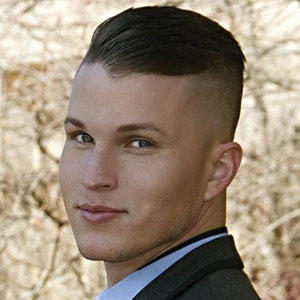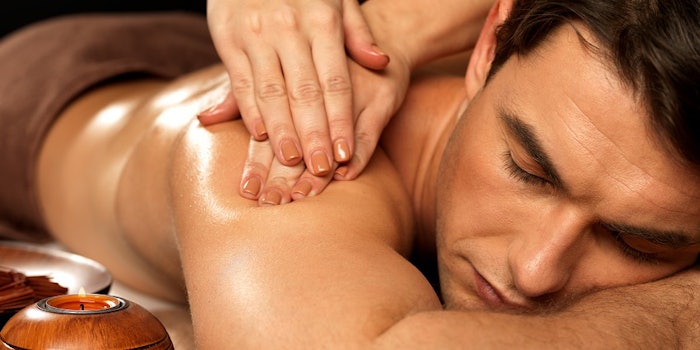
Massage—it is our go-to treatment to de-stress, unwind and relieve tired, aching muscles. In fact, it’s been the go-to treatment for over 4,500 years, with the first records of massage therapy being found in the ancient Chinese text, The Yellow Emperor’s Classic Book of Internal Medicine. The knowledge it contained really stood the test of time, as the published English version is still considered an essential tool in herbology, acupressure and acupuncture training. The Egyptians were additionally one of the first civilizations to utilize massage as a therapeutic modality, with tomb paintings depicting massage as a medical practice dating as far back as 2500 B.C. Both Chinese and Egyptian cultures are also to thank for pioneering reflexology. Of course, massage therapy has evolved substantially, begging the question, are we as estheticians evolving with time when it comes to our facial massage treatments?
When it comes to massage, we typically associate it with our back, neck and shoulders, but what about therapeutic massage for the face? We all hopefully learned the three basic massage techniques in school—effleurage, petrissage and tapotement, or as I call it “passing your state boards.” Some of us were also fortunate enough to learn more advanced massage techniques, such as Swedish massage to relax, tighten and tone the skin or pressure point massage to increase blood flow and circulation. If we were lucky enough as students, we also had an opportunity to learn manual lymphatic drainage to detoxify, stimulate and remove waste material from the lymph system. Beyond this, unfortunately, the general consensus I’ve received after traveling for almost eight years and training over 7,000 people is that massage therapists and estheticians feel previous training offered in facial massage was severely lacking.
My Story of Discovery
In the beginning years of working as an esthetician, I considered myself one of the fortunate estheticians to have quite a few massage techniques under my belt. Overall, the massage techniques served me well, as they got rave reviews from clients, and customers always commented on how relaxed they were after the facial or how good the massage felt. Over time, though, I went from settling into a routine to feeling stuck in a routine. Luckily, this was all about to change when I had an opportunity to attend my first trade show.
I attended a master class involving facial massage with a critical outlook, having attended continuing education on facial massage before with little learned. Once the facial massage demonstration started, to say my jaw dropped would be an understatement. The instructor’s hands were lifting, rolling and manipulating the facial muscle structure in a way I had never seen before. Muscle, fascia, and lymph were all being redirected and stimulated at masterful, lightning quick speed, all while keeping a rhythm, slowing and focusing on key areas to relieve tension, breaking down adhesions that form with aging and stress. In addition, I witnessed a new type of friction massage I had never seen before, which looked like fingertips were erasing and flattening wrinkles.
Just as I started to comprehend what was happening, the demonstration moved on to the hands and arms, stretching and extending the muscles through to the shoulders before kneading all the way from the model’s shoulders, down the muscles of the back to the hips. This was all without ever having to have the model turn over to have her lie face down. When the entire treatment was complete, the model wasn’t just relaxed—she looked like she’d received a facelift. Her brows, jowls and cheeks were lifted at least one-quarter to half an inch. Any wrinkles on the neck, forehead and between the brows were virtually gone, and she had an unreal glow illuminating from her skin. I decided right in that moment that I had to learn those massage techniques.
As I refined and incorporated the massage techniques into my own facials, I saw an immediate jump in client re-bookings, referrals and gratuity. My clients also saw better results from the facials I was giving them and over time. I was able to book virtually all of the clients for lifting treatments between their monthly facials to draw extended revenue, which only increased their results further, especially in the department of reducing edema or swelling.
The Science Behind the Magic
The number of muscles in the face can vary per person, but the average face contains around 43 muscles and a complex, differing muscle structure from the rest of the body. The muscles in the body are attached to the bones directly via tendons, whereas the facial muscles are attached directly to the skin with only some of them attaching to the bone. Not surprisingly, these areas that don’t attach to the bone (the eyes and mouth) are the areas that typically age the quickest, due to not having any anchor against gravity.
Humans utilize almost all of the muscles in our face continually for facial expression, and virtually every form of tension in the body is reflected in the face. It only makes sense that a therapeutic level of massage would have an incredible amount of benefits toward reducing the signs of aging. So then, what exactly is the science behind the magic of massage? It can be summarized in one word—injury.
We all remember being taught in esthetic’s school to always use light pressure on the face when performing massage and to not pull on the skin or massage it downwards because it will age quicker. While this would be true if we were doing it two to three times a day, once a month of more intense massage with greater pressure in the appropriate areas won’t hurt anyone. I know, putting the words injury and skin next to each other sounds scary. Creating injury typically has negative connotations, especially when it comes to the skin and premature aging, but the injury I am referring to is friction, rolling and kneading with a greater amount of pressure than we are used to. Sometimes in order to evolve our education, we have to unlearn what we’ve been taught and move on to new practices.
These types of injuries, specifically friction, activate certain parts of the nervous system which trigger vasodilation or the widening of blood vessels. Histamine is also released, and the resulting flush is a temporary inflammatory response stimulating blood flow, directing fresh oxygen, nutrients, and flooding reparative cells into the damaged tissue.1 This increase in circulation also pushes toxins and harmful inflammatory cells out of the tissue resulting in a reduction of edema or swelling. Another benefit of this injury and friction is the stimulation of fibroblast proliferation,2-3 which is responsible for the creation of collagen cells, one of the most important components of skin’s resilience. Fibroblasts are also involved in the construction of elastin, glycosaminoglycans, fibers and proteins, which comprise the structure of the extra cellular matrix (ECM). The ECM is a gel-like structure that gives the skin its properties of elasticity, strength and the ability to un-wrinkle after being compressed. It also regulates cell functions and acts as a transportation system for nutrients and waste materials.
3 Techniques to Learn
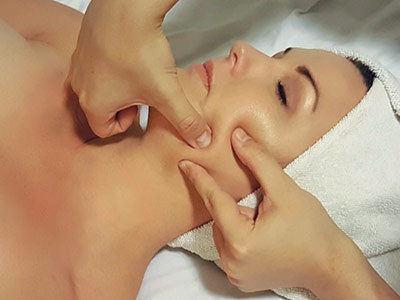
1. Jaw lymph drain and collagen stimulator. This move allows the practitioner to tighten, tone and stimulate the skin as well as the muscle along the jaw line, which starts to lose elasticity with age. This massage motion creates friction for collagen stimulation, relaxes the risorius, masseter, platysma, and depressor muscles all while assisting lymph drainage to remove toxins. The thumb moves in three rocking motions starting from the center of the chin, next along the jawline and then toward the ear while intersecting the opposite hand’s thumb and index finger with each motion. The pressure always moves toward the ear with the thumb to ensure lymph moves in the correct direction.
2. Line filler. Using friction, this massage creates the “good”
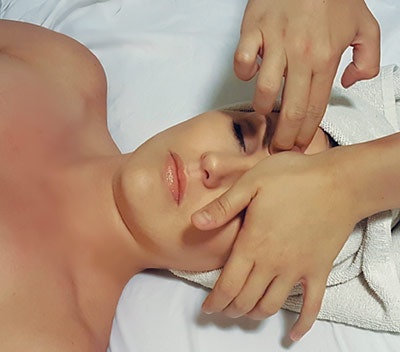
inflammatory response that floods the area with reparative fibroblasts, boosting collagen repair and instantly smoothing fine lines. The head is braced by pressing the padded section of the palm on your nondominant hand into the forehead with deep pressure, focusing on the frontalis muscles. As that hand braces the head, press the pads of your index and middle finger on your opposing hand into the wrinkles and start to create friction in the opposite direction of the lines (vertical friction for horizontal lines, horizontal friction for vertical lines). This move is also fabulous for stretch marks or scarring on the body.
3. Brow lift. This massage move awakens the eyes and take years off of aging. Using the index finger and thumb, this move manipulates virtually all muscles around the eye (procerus, orbicularis oculi and corrugator) to lift, redirect and break down collagen adhesions (bad knots) that form and accelerate aging. Press the pads of the index fingers into the sinus point below the brow and the pads of the thumbs on the hairline directly above. Move the thumbs down to meet the index fingers
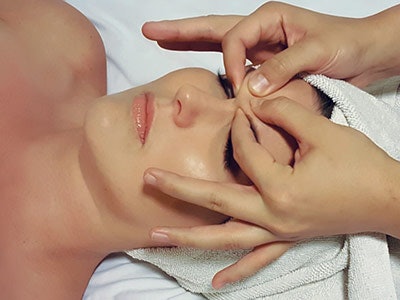
until you can pinch and lift the brows and then roll the index fingers outward toward the arch of the brow, moving upward.
A Tool for your Toolkit
Expanding on our current massage techniques is like adding an additional, invaluable tool for our toolkits as estheticians. Massage allows us to connect with our clients emotionally, differentiate from our competitors, increase the effectiveness of our roles and make us indispensable as service providers so that we are no longer just a luxury-based service, but a necessity.
A spa that I recently had the pleasure of training on massage did the most important step after training—they followed through. The spa director ensured that all estheticians continued to master the massage moves and standardized the facial services so that every guest received the full facial massage experience. Their facial business went up 300%, which also increased retail sales potential and public visibility of the spa as a brand. This was in a competitive marketplace for spas, so the result achieved was all that more special.
Your clients value you, not just the types of facials you provide or the numberless, hot, trending machines that can be used in service. Evolving our massage is a built-in, affordable investment we can make in ourselves today.
REFERENCES
- MT Carey-Loghmani and WI Hammer, Graston Technique, in Functional Soft-Tissue Examination and Treatment by Manual Methods, 3rd Edition, WI Hammer, ed, Jones & Bartlett: Sudbury, MA 589-625 (2007)
- W Hammer, The effect of mechanical load on degenerated soft tissue, Journal of Bodywork and Movement Therapies 12 246–256 (2008)
- MT Loghmani and SJ Warden, Instrument-assisted cross-fiber massage accelerates knee ligament healing, Journal of Orthopaedic & Sports Physical Therapy, Jul 39(7) 506-514 (2009)
